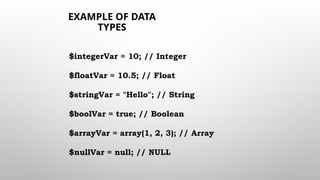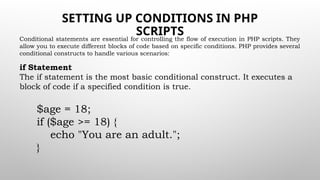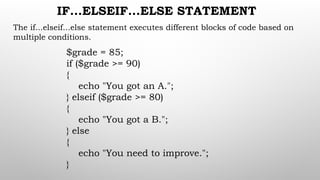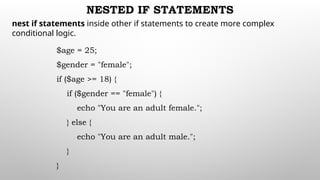Jquery in web development, including Jquery in HTML
- 1. jQuery is a lightweight, "write less, do more", JavaScript library. The purpose of jQuery is to make it much easier to use JavaScript on your website. jQuery takes a lot of common tasks that require many lines of JavaScript code to accomplish, and wraps them into methods that you can call with a single line of code. jQuery also simplifies a lot of the complicated things from JavaScript, like AJAX calls and DOM manipulation. The jQuery library contains the following features: HTML/DOM manipulation CSS manipulation HTML event methods Effects and animations AJAX jQuery
- 2. jQuery Applications There are lots of other JavaScript libraries out there, but jQuery is probably the most popular, and also the most extendable. Many of the biggest companies on the Web use jQuery, such as: • Google • Microsoft • IBM • Netflix
- 3. Adding jQuery to Your Web Pages There are several ways to start using jQuery on your web site. You can: Download the jQuery library from jQuery.com Include jQuery from a CDN (Content Delivery Network) Versions of jQuery There are two versions of jQuery available for downloading: Production version - this is for your live website because it has been minified and compressed Development version - this is for testing and development (uncompressed and readable code
- 4. There are two ways of including jquery, either from google or microsoft. Google CDN (Content Delivery Network) <head> <script src="https://ajax.googleapis.com/ajax/libs/jquery/3.3.1/jquery.min.js"></ script> </head> Microsoft CDN (Content Delivery Network) <head> <script src="https://ajax.aspnetcdn.com/ajax/jQuery/jquery-3.3.1.min.js"> </script> </head> Adding jQuery to your website
- 5. The main methods for manipulating HTML content in jQuery are: html(): Sets or returns the content of selected elements $("selector").html() returns the HTML content of the first matched element $("selector").html("new content") sets the HTML content of the matched elements $("selector").html(function(index, currentcontent)) sets the content using a function text(): Sets or returns the text content of selected elements Manipulating HTML Content
- 6. EXAMPLE // Set the content of an element $("h2").html("Hello <b>World!</b>"); // Return the content of the first matched element alert($("h2").html()); // Set content using a function $("h2").html(function(n)) { return "jQuery | html() Method" + " has index: " + n; });
- 7. ADDING AND REMOVING CLASSES addClass(): Adds one or more class names to selected elements removeClass(): Removes one or more classes from selected elements toggleClass(): Toggles between adding/removing one or more classes from selected elements // Add a class $("a").addClass("bold"); // Remove a class $("a").removeClass("bold");
- 8. Inserting and Replacing Content jQuery provides several methods for inserting and replacing HTML content: append(): Inserts content at the end of selected elements prepend(): Inserts content at the beginning of selected elements after(): Inserts content after selected elements before(): Inserts content before selected elements replaceWith(): Replaces selected elements with new content
- 9. // Append content $("div").append("<p>Appended text</p>"); // Prepend content $("div").prepend("<p>Prepended text</p>"); // Insert after $("div").after("<p>Inserted after</p>"); // Replace with $("div").replaceWith("<p>Replaced div</p>"); Example
- 10. PHP PHP, which stands for "PHP: Hypertext Preprocessor," is a widely-used open-source server-side scripting language primarily designed for web development. Server-Side Execution: PHP scripts are executed on the server, generating HTML that is sent to the client's browser. This allows for dynamic content generation based on user input or other variables. Integration with HTML: PHP can be easily embedded within HTML code, allowing developers to mix PHP and HTML seamlessly. This makes it easier to create dynamic web pages. Database Support: PHP has built-in support for various databases such as MySQL, PostgreSQL, and SQLite, enabling developers to create data-driven applications. Cross-Platform Compatibility: PHP runs on various operating systems, including Windows, Linux, and macOS, making it versatile for different server environments. Open Source: Being open-source means PHP is free to use, and it has a large community of developers contributing to its continuous improvement and extensive documentation.
- 11. Dynamic Web Pages: PHP is primarily used to create dynamic web pages that can respond to user inputs and display different content based on various conditions. Form Handling: PHP can collect and process form data, making it essential for applications that require user interaction. Session Management: PHP can manage user sessions, allowing for personalized experiences on websites. File Handling: PHP can create, read, write, and delete files on the server, facilitating various functionalities like file uploads and downloads. Uses of PHP
- 12. Basic Syntax A typical PHP file has a .php extension and can contain HTML, CSS, JavaScript, and PHP code. The basic syntax for embedding PHP in an HTML document is <html> <head> <title>PHP Example</title> </head> <body> <?php echo "Hello, World! This is PHP code.";?> </body> </html>
- 13. VARIABLES, CONSTANTS, DATA TYPES, AND ARRAYS IN PHP Variables A variable in PHP is a container for storing data. It is defined by a name that starts with a dollar sign ($), followed by the variable name. PHP automatically assigns a data type to a variable based on the value assigned to it. Rules for Naming Variables Must start with a dollar sign ($). Followed by a letter or an underscore, and can contain letters, numbers, and underscores. Variable names are case-sensitive (e.g., $myVar and $myvar are different).
- 14. EXAMPL E $age = 25; // Integer $name = "John"; // String $height = 5.9; // Float $isStudent = true; // Boolean
- 15. CONSTANTS • Constants are similar to variables but are immutable; once defined, their value cannot change during the execution of the script. • Constants are defined using the define() function or the const keyword, and they do not require a dollar sign. define("PI", 3.14); // Using define() const GRAVITY = 9.81; // Using const
- 16. DATA TYPES PHP Supports several data types, which can be categorized into simple, compound, and special data types: 1.Simple Data Types Integer: Whole numbers, e.g., 42, -7. Float: Decimal numbers, e.g., 3.14, -0.001. String: Sequence of characters, e.g., "Hello, World!". Boolean: Represents two states, true or false. 2.Compound Data Types Array: A collection of values, which can be of mixed types. Object: An instance of a class. 3.Special Data Types NULL: Represents a variable with no value. Resource: A special variable that holds a reference to an external resource, like a database connection.
- 17. EXAMPLE OF DATA TYPES $integerVar = 10; // Integer $floatVar = 10.5; // Float $stringVar = "Hello"; // String $boolVar = true; // Boolean $arrayVar = array(1, 2, 3); // Array $nullVar = null; // NULL
- 18. ARRAYS Arrays in PHP can store multiple values in a single variable. They can be indexed (numerical) or associative (key-value pairs). $colors = array("Red", "Green", "Blue"); echo $colors[0]; // Outputs: Red $person = array("name" => "John", "age" => 30); echo $person["name"]; // Outputs: John Associative Array Indexed Array
- 19. SETTING UP CONDITIONS IN PHP SCRIPTS Conditional statements are essential for controlling the flow of execution in PHP scripts. They allow you to execute different blocks of code based on specific conditions. PHP provides several conditional constructs to handle various scenarios: if Statement The if statement is the most basic conditional construct. It executes a block of code if a specified condition is true. $age = 18; if ($age >= 18) { echo "You are an adult."; }
- 20. IF...ELSE STATEMENT The if...else statement executes a block of code if a condition is true, and another block if the condition is false. $temperature = 25; if ($temperature > 30) { echo "It's hot outside."; } else { echo "The weather is pleasant."; }
- 21. IF...ELSEIF...ELSE STATEMENT $grade = 85; if ($grade >= 90) { echo "You got an A."; } elseif ($grade >= 80) { echo "You got a B."; } else { echo "You need to improve."; } The if...elseif...else statement executes different blocks of code based on multiple conditions.
- 22. NESTED IF STATEMENTS $age = 25; $gender = "female"; if ($age >= 18) { if ($gender == "female") { echo "You are an adult female."; } else { echo "You are an adult male."; } } nest if statements inside other if statements to create more complex conditional logic.
- 23. SWITCH STATEMENT The switch statement is an alternative to multiple if...elseif statements. It executes different blocks of code based on different cases. $day = 3; switch ($day) { case 1: echo "Monday"; break; case 2: echo "Tuesday"; break; case 3: echo "Wednesday"; break; default: echo "Invalid day"; }
- 24. REPEATING ACTIONS WITH LOOP IN PHP Loops in PHP allow you to repeatedly execute a block of code until a certain condition is met. This is useful when you need to perform an action multiple times or iterate over a collection of data. PHP provides several types of loops for Loop while Loop do...while Loop foreach Loop
- 25. for Loop The for loop is used when you know in advance how many times the loop should execute. It consists of three parts separated by semicolons: initialization, condition, and increment/decrement. for ($i = 1; $i <= 5; $i++) { echo "Iteration $i<br>"; } Output Iteration 1 Iteration 2 Iteration 3 Iteration 4 Iteration 5
- 26. while Loop The while loop continues to execute a block of code as long as a specified condition is true. $count = 1; while ($count <= 3) { echo "Count: $count<br>"; $count++; } Output Count: 1 Count: 2 Count: 3
- 27. do...while Loop The do...while loop is similar to the while loop, but it guarantees that the code block is executed at least once before the condition is tested. $i = 1; do { echo "Value of i: $i<br>"; $i++; } while ($i <= 5); Output Value of i: 1 Value of i: 2 Value of i: 3 Value of i: 4 Value of i: 5
- 28. foreach Loop The foreach loop is specifically designed for iterating over arrays and objects. It automatically assigns each value of the array to a variable. $fruits = array("apple", "banana", "cherry"); foreach ($fruits as $fruit) { echo "I like $fruit<br>"; } Output I like apple I like banana I like cherry
- 29. USING FUNCTIONS IN PHP Functions in PHP are blocks of code designed to perform specific tasks. They enhance code reusability, maintainability, and organization. PHP supports two main types of functions: built-in functions and user-defined functions.
- 30. PHP comes with a vast library of built-in functions, which are pre-defined and ready to use. These functions cover a wide range of tasks, including string manipulation, mathematical calculations, and file handling. Examples strlen(): Returns the length of a string. array_push(): Adds one or more elements to the end of an array. var_dump(): Displays structured information about one or more variables. Built-in Functions
- 31. USER-DEFINED FUNCTIONS User-defined functions allow you to create your own functions tailored to your specific needs. function functionName($parameter1, $parameter2) { // code to be executed } function sample($name) { echo "Hello, $name!"; } // Calling the function sample("Abc"); Syntax Example
- 32. FUNCTION PARAMETERS Functions can accept parameters, which are variables passed into the function. You can define multiple parameters, separated by commas. function add($a, $b) { return $a + $b; } $result = add(5, 10); echo "The sum is: $result"; // Outputs: The sum is: 15
- 33. DEFAULT PARAMETER VALUES You can set default values for parameters. If a value is not provided during the function call, the default value will be used. function greet($name = "Guest") { echo "Hello, $name!"; } greet(); // Outputs: Hello, Guest! greet("Bob"); // Outputs: Hello, Bob!
- 34. RETURNING VALUES Functions can return values using the return statement. Once a return statement is executed, the function stops executing. function square($number) { return $number * $number; } echo "The square of 4 is: " . square(4); // Outputs: The square of 4 is: 16
- 35. CALL BY VALUE VS. CALL BY REFERENCE By default, PHP passes arguments to functions by value, meaning a copy of the variable is passed. If you want to pass a variable by reference (allowing the function to modify the original variable), you can use the & symbol. function increment(&$value) { $value++; } $num = 5; increment($num); echo $num; // Outputs: 6

















![ARRAYS
Arrays in PHP can store multiple values in a single variable. They can be indexed
(numerical) or associative (key-value pairs).
$colors = array("Red", "Green", "Blue");
echo $colors[0]; // Outputs: Red
$person = array("name" => "John", "age" => 30);
echo $person["name"]; // Outputs: John
Associative Array
Indexed Array](https://image.slidesharecdn.com/jquery-240917124517-8ede1aea/85/Jquery-in-web-development-including-Jquery-in-HTML-18-320.jpg)
















